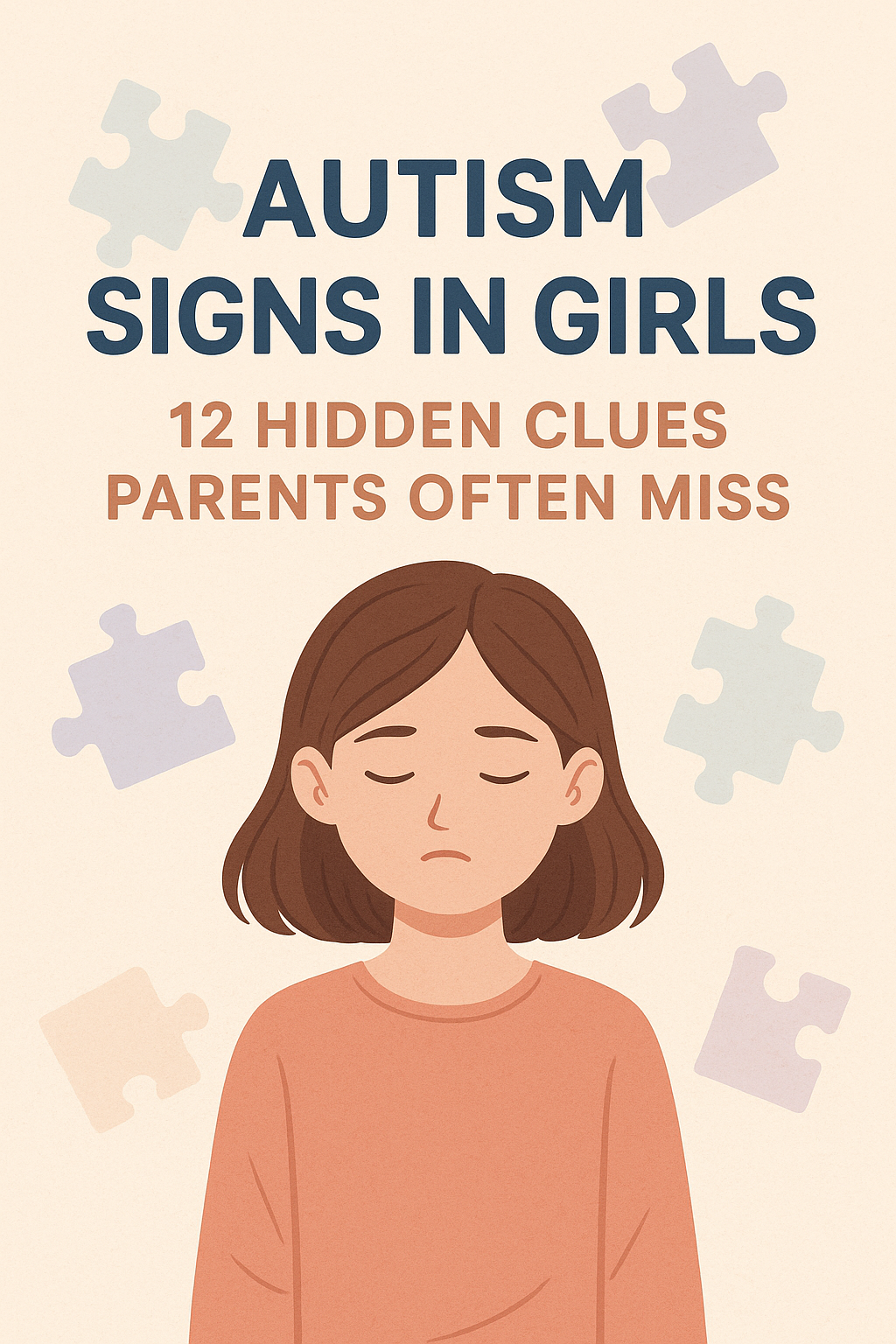Autism Signs in Girls: 12 Hidden Clues Parents Often Miss

Autism signs in girls look nothing like what most parents expect to see.
Note: I am NOT a doctor, psychologist, or psychiatrist; just a dad who’s seen a lot with a lot of education and experience under my belt. I will never claim to be anything other than what I am on this site.
Parent-teacher conferences used to feel like victories in our house.
“She’s such a good listener!” they’d say about one of my daughters. “Never causes trouble. Always follows directions.” 🎯
I’d nod, smile, shake hands. Then we’d get home, and she’d collapse on the couch—completely drained, sometimes in tears, unable to explain why school felt so hard even though her grades were perfect.
That disconnect haunted me for years before I understood what was really happening.
Here’s what nobody tells you at those conferences: quiet isn’t the same as calm. For some girls, especially those on the autism spectrum, that “model student” behavior comes at an enormous cost. They’re not naturally easygoing—they’re working overtime to appear that way, and by the time they get home, there’s nothing left in the tank. 😔
The problem? Autism signs in girls get missed. A lot. And not because parents aren’t paying attention, but because the signs look completely different than what we’ve been taught to watch for. While boys with autism might display more obvious behaviors—repetitive movements, intense special interests, clear social struggles—girls often fly under the radar, masking their differences so well that even trained professionals miss the clues.
If you’ve ever felt like something’s off but can’t quite put your finger on it, you’re not imagining things. Let me walk you through what I’ve learned—both as a dad of six and from watching this play out in real families around us.

Why Autism Looks Different in Girls
The research is pretty clear on this: girls with autism are significantly underdiagnosed compared to boys. According to the CDC, autism spectrum disorder is about three times more common in boys than girls—but experts believe that’s not because girls have less autism. It’s because we’re not recognizing it when it’s right in front of us.
The Gender Gap in Diagnosis 📊
| Statistic | Reality |
|---|---|
| Boys diagnosed vs. Girls | 4:1 ratio (CDC data) |
| Actual autism prevalence | Experts believe gap is much smaller |
| Average diagnosis age (girls) | 2-3 years later than boys |
| Misdiagnosis rate | Significantly higher in females |
So why the gap?
Girls are naturally better at something called masking—the process of hiding autistic traits to fit in socially. They watch other kids like they’re studying for a test, mimicking facial expressions, copying conversation patterns, and learning social scripts by heart. On the surface, it looks like typical development. Underneath, it’s exhausting mental labor.
The Masking Cycle →
✓ Observe peers intensely
✓ Copy “acceptable” behaviors
✓ Suppress natural responses
✓ Maintain performance all day
✓ Complete emotional collapse at home
My wife teaches middle school math, and she’s seen this pattern repeatedly. A girl who seems perfectly fine at school—participating in groups, answering questions, handling transitions—might be completely overwhelmed at home. That’s because school is a performance, and home is where the mask finally comes off.

The Mayo Clinic notes that girls often develop coping mechanisms that make their struggles less visible. They might have fewer obvious repetitive behaviors or intense fixations (or at least, their interests blend in better—nobody questions a girl obsessed with horses or books the way they might a boy obsessed with train schedules). 📚🐴
But here’s the cost: that constant effort to “act normal” leads to anxiety, depression, and complete emotional crashes. The meltdowns don’t happen at school where everyone can see them. They happen at home, where it’s safe to fall apart. And parents are left wondering why their “perfect” child is so dysregulated the moment they walk through the door.
Energy Depletion Chart 📉
School Day Energy Levels (Masked Girl):
Morning ████████████████ 100% - Full mask on
Midday ████████░░░░░░░░ 50% - Struggling to maintain
After ███░░░░░░░░░░░░░ 20% - Barely holding on
Home ░░░░░░░░░░░░░░░░ 0% - Complete collapse
I’ve watched this in our own home. One daughter would hold it together all day—cooperative, pleasant, no complaints—then have a complete breakdown over something minor like the wrong color plate at dinner. It wasn’t about the plate. It was about running out of capacity to keep performing.
Understanding this pattern is the first step in recognizing autism signs in girls. Once you know what you’re looking for, those “hidden” clues start making a lot more sense.
12 Hidden Clues Grouped by Type
Let me break down the specific behaviors that often get missed. These aren’t the stereotypical signs you read about in most articles. These are the subtle, easy-to-overlook patterns that parents need to know about when identifying autism signs in girls. 🔍
Social Differences 👥
1. Copy-Friendship Instead of Connection
Watch how your daughter interacts with friends. Does she have one “best friend” she mirrors constantly—copying their interests, speech patterns, even mannerisms? This isn’t typical friendship; it’s often a coping strategy. She’s using that friend as a social template, studying them to figure out how to act in different situations.
Red flags include:
→ Complete personality shifts based on who she’s with
→ No consistent “self” across different friend groups
→ Extreme distress when the template friend is absent
→ Difficulty explaining why she likes what she likes
In our extended family, we noticed one girl who switched entire personalities depending on which friend she was with that week. It looked like typical kid behavior at first, but the pattern was too extreme, too deliberate. She wasn’t discovering herself—she was borrowing identities to survive social situations.
2. Scripted Responses
Listen to how your daughter answers questions. Does she use the same phrases repeatedly, especially in social situations? Girls with autism often memorize “correct” responses and pull them out like flashcards. 💬
“How was your day?” “Fine!”
“Did you have fun?” “Yeah, it was good!”
Every. Single. Time. Same words, same tone. It’s not rudeness—it’s a script that works, so she sticks with it.
3. Extreme Perfectionism
This one’s tricky because we celebrate high achievement. But when perfectionism crosses into anxiety territory—when a small mistake leads to tears, when “good enough” doesn’t exist, when she’d rather not try than risk failure—you might be looking at something deeper. ⚠️
Perfectionism warning signs:
• Erasing homework repeatedly until it’s “right”
• Meltdowns over minor errors
• Refusing to participate if unsure of success
• Rigid rules about how things “should” be
• Extreme distress over grades or feedback
The need for perfection isn’t about being a good student. It’s about maintaining control in a world that feels unpredictable and overwhelming. If everything is perfect, maybe she can keep the anxiety at bay.
4. Social Exhaustion
Does your daughter love playdates—for exactly 47 minutes, and then she’s done? Does she need hours of alone time after school? This pattern of social fatigue is a major red flag that masking is happening. 😴
Daily Social Capacity Tracker 📊
Typical Girl Autistic Girl (Masked)
│ │
│ ████████████ │ ███████░░░░░
│ Recharges │ Depletes rapidly
│ with people │ needs isolation
│ │
└───────────── └─────────────
Social Time Social Time
One of my daughters used to beg to have friends over, then hide in her room within an hour. We thought she was being rude. Now I understand she genuinely wanted connection but didn’t have the capacity to maintain it.
Sensory Differences 👗🔊
5. Texture Wars
I’m not talking about picky eating (though that’s part of it). I’m talking about wars over clothing textures, food consistency, or anything touching her skin. Tags must be cut out. Seams must line up perfectly. Certain fabrics are completely off-limits.
Common sensory battlegrounds:
✗ Sock seams against toes
✗ Scratchy fabric anywhere on skin
✗ Tags rubbing on neck
✗ Tight waistbands or collars
✗ Certain food textures (mushy, slimy, etc.)
This isn’t about being difficult. It’s about genuine sensory discomfort that feels physically painful. Golden Care Therapy explains that sensory processing differences are common in autism, and for many girls, clothing is the biggest daily battle.
6. Noise Sensitivity
Does your daughter cover her ears in crowds? Does she complain that the refrigerator hum is “too loud” when you barely notice it? Does she struggle in loud restaurants, school cafeteria, or anywhere with overlapping sounds? 🙉
Sound Processing Comparison
Neurotypical Brain: Autistic Brain:
[Background noise] [BACKGROUND NOISE!!!]
[Conversation] [Conversation]
[Music] [MUSIC!!!]
[Every. Single. Sound.]
Filters automatically No filter - hears everything
Auditory sensitivity can be severe in girls with autism, even when they don’t show other obvious signs. They’re hearing everything at once, unable to filter background noise the way neurotypical brains do automatically.
7. Wardrobe Control
This goes beyond normal preferences. Some girls with autism will wear the same outfit for weeks or have very rigid rules about what’s acceptable. It’s not fashion—it’s predictability. The known outfit feels safe. New clothes, even if similar, feel wrong. 👕
We’ve had battles over washing favorite shirts because the day without them was unbearable. Not dramatic kid stuff—genuine distress over breaking a pattern that helped regulate her nervous system.
Emotional Regulation 💔
8. After-School Meltdowns
I mentioned this earlier, but it deserves its own spot. If your daughter is calm and cooperative everywhere except home, that’s a massive clue. The meltdowns—crying, anger, shutting down—aren’t behavior problems. They’re emotional releases after hours of holding everything together.
Typical after-school pattern
3:00 PM – Walks in door
3:15 PM – Minor trigger (wrong snack, sibling talking)
3:20 PM – COMPLETE MELTDOWN
4:30 PM – Finally calm after alone time
Think of it like this: she’s been clenching every muscle all day, and home is where she finally lets go. The crash is inevitable, and it’s not her fault.
9. Anxiety Loops
Does your daughter get stuck on worries? Not just “I’m nervous about the test” but full spirals: “What if I fail? What if everyone thinks I’m dumb? What if the teacher calls on me and I freeze?” The worry feeds on itself, growing bigger and more catastrophic. 🌀
Anxiety spiral pattern:
→ Small worry enters mind
→ Brain adds worst-case scenarios
→ Logic can’t break the cycle
→ Physical symptoms appear
→ More worry about the symptoms
→ Complete overwhelm

Girls with autism often struggle with anxiety that feels impossible to control. It’s not just worry—it’s rumination that takes over completely.
10. Rigid Routines
Morning routine must happen in exact order. Dinner at the same time. Bedtime ritual with no variations. When something disrupts the pattern, panic sets in. ⏰
Routine Flexibility Scale 📏
Neurotypical: ████████████████░░░░ 80% flexible
Autistic: ████░░░░░░░░░░░░░░░░ 20% flexible
Routine disruption = System overload
Routines aren’t just preferences for these kids—they’re survival tools. The predictable structure helps manage the chaos of an unpredictable world. Mess with the routine, and the whole day feels unsafe.
Additional Patterns 🔍
11. Intense, Narrow Interests
This might look more “acceptable” in girls—loving horses, reading constantly, knowing everything about a particular TV show. But the intensity is the key. It’s not casual interest; it’s all-consuming focus that dominates thoughts and conversation. 📖
Interest intensity markers:
• Can talk for hours about the topic
• Gets upset when others aren’t interested
• Reads/watches/researches obsessively
• Becomes distressed if unable to engage with interest
• Most conversations circle back to this topic
One family we know has a daughter who reads only fantasy novels—same genre, same themes, over and over. She can tell you every detail of world-building from her favorite series but struggles to discuss anything outside that narrow focus.
12. Literal Thinking
Sarcasm doesn’t land. Idioms are confusing. Instructions need to be very specific, or she’ll follow them literally in ways that don’t make sense. 🤔
Examples of literal interpretation:
→ “Give me a hand” = Holds out her hand
→ “Hold your horses” = Confused (no horses present)
→ “It’s raining cats and dogs” = Looks outside for animals
→ “Break a leg” = Genuine concern about injury
It’s not that she’s being difficult—her brain processes language exactly as spoken.
🎯 Quick Tip for Parents: Instead of tracking symptoms, try keeping a two-week “energy log.” Note when your daughter seems drained, when she struggles with transitions, when meltdowns happen. Patterns will emerge that help you see what’s really going on, especially if you’re noticing multiple autism signs in girls across different settings.
Energy Log Template 📝
Day | Morning | School | After School | Evening
----|---------|--------|--------------|--------
Mon | ☺️ | 😐 | 😫 | 😴
Tue | ☺️ | 😐 | 😭 | 😴
[Pattern reveals masking & crashes]
When to Ask for Help
So you’re reading this list, and things are clicking into place. Now what? 🤷♂️
First, take a breath. Recognizing these patterns doesn’t mean something’s wrong with your daughter. It means you’re paying attention, and that’s exactly what she needs.
Here’s the thing about getting help: you don’t need to have all the answers before you start. You just need to document what you’re seeing and bring it to the right people.
Start with Documentation 📋
For two weeks, keep simple notes:
✓ What time of day do struggles happen?
✓ What triggers meltdowns or shutdowns?
✓ When does she seem most comfortable?
✓ What helps her regulate?
You’re not diagnosing—you’re gathering data. When you talk to professionals, specific examples matter more than vague concerns. “She’s often overwhelmed” is harder to assess than “She melts down every day after school, needs 90 minutes alone, and can’t handle unexpected schedule changes.”
Documentation Checklist 📌
| Area | What to Track |
|---|---|
| Social | Friend interactions, scripts, exhaustion patterns |
| Sensory | Texture refusals, noise complaints, wardrobe battles |
| Emotional | Meltdown triggers, anxiety topics, regulation needs |
| Routine | Daily patterns, disruption reactions, flexibility limits |
Talk to Your Pediatrician 👨⚕️
Schedule a dedicated appointment (not a quick sick visit). Bring your notes. Be direct: “I’m seeing patterns that concern me, and I’d like to explore whether autism could explain what’s happening.”
Key phrases to use:
→ “I’m noticing autism signs in girls that match what I’m seeing”
→ “These aren’t typical developmental concerns”
→ “Her struggles are hidden but significant”
→ “I need a referral for evaluation”
Some pediatricians will take this seriously. Others won’t. If your doctor dismisses your concerns with “She’s just shy” or “Girls don’t have autism like that,” find a different doctor. You know your child, and female autism traits are real even if they’re less recognized.
Consider a Formal Evaluation 🏥
If your pediatrician agrees there’s reason for concern, they’ll refer you for a comprehensive evaluation. This typically involves:
✓ Developmental specialists
✓ Psychological testing
✓ Behavioral observations
✓ Input from teachers and caregivers
The process isn’t quick, and waitlists can be long (sometimes 6+ months). Get on the list while you work on support strategies at home.
Evaluation Timeline 📅
Month 1: Initial pediatrician visit
↓
Month 2: Referral & paperwork
↓
Month 3-8: Waitlist period
↓
Month 9: Comprehensive evaluation
↓
Month 10: Results & recommendations
You Don’t Need a Label to Start Helping ⭐
Here’s something that took me too long to figure out: you can implement autism-friendly strategies at home right now, whether or not your daughter has an official diagnosis.
If sensory issues are real, addressing them helps regardless of the underlying cause. If social situations drain her, building in recovery time makes sense for any kid who needs it. If routines reduce anxiety, create them.
We spent years waiting for answers before we realized we could start making life easier immediately. Don’t make that same mistake. ⏳
Connect with Other Parents 🤝
One of the most valuable things we did was joining online communities for parents navigating similar concerns. Hearing other families describe their experiences made us feel less alone and gave us practical ideas we’d never have thought of ourselves.
If you’re seeing communication struggles in autistic children, you’re not the first parent to face this. Learning from others who’ve walked this road makes everything more manageable.
The same goes for disciplining autistic children—traditional discipline approaches often backfire, and connecting with experienced parents can save you months of frustration.
Be Prepared for a Long Process ⌛
Getting a late diagnosis of autism in girls is common, but it’s rarely fast. The system isn’t built for girls who mask well, and you’ll likely face skepticism along the way.
Stay persistent. Keep documenting. Trust your instincts. If something feels off, keep pushing for answers even when professionals tell you everything’s fine. 💪
Supporting Girls at Home and School
Whether you’re still in the evaluation process or you already have answers, practical support makes an immediate difference. Let me share what actually works. 🏠
Create Predictable Structure 🗓️
Routines aren’t just helpful—they’re essential. When the world feels chaotic and overwhelming, knowing what comes next provides crucial stability.
In our house, we use:
✓ Visual schedules (even for teenagers)
✓ Consistent morning and evening routines
✓ Advance warning before transitions
✓ Clear expectations laid out ahead of time
Does this feel rigid? Sometimes. But the reduction in anxiety makes it worth every bit of planning.
Sample Morning Routine Visual 🌅
□ Wake up alarm (7:00 AM)
□ Bathroom routine (10 min)
□ Get dressed (same outfit okay!)
□ Breakfast (predictable options)
□ Brush teeth
□ Pack bag (checklist on door)
□ Leave house (7:45 AM)
Everything in order = Calm start
Build in Recovery Time 🛋️
If masking is happening at school, home needs to be a safe space to drop the act. This means:
→ Quiet time after school (no questions, no demands, no socializing)
→ A sensory-friendly space she can retreat to
→ Permission to say no to extra activities when she’s drained
→ Acceptance that weekends might be mostly recovery days
I used to push for family activities on weekends, frustrated when one daughter wanted to stay home. Now I understand that rest is the activity. Her nervous system needs downtime to reset, and that’s not negotiable. 😴
Recovery Space Essentials 🏠
| Item | Purpose |
|---|---|
| Dim lighting | Reduces sensory input |
| Soft textures | Comfortable without irritation |
| Quiet zone | No sibling intrusion |
| Favorite items | Comfort objects allowed |
| No demands | True rest, not “productive” time |
Address Sensory Needs 👕
Stop fighting the clothing battles. Seriously. Life is too short to force uncomfortable clothes on a kid who’s already struggling.
Practical accommodations:
✓ Let her pick her own clothes (even if it’s the same outfit daily)
✓ Remove all tags and choose seamless options
✓ Stock safe foods without judgment
✓ Provide noise-canceling headphones for overwhelming environments
✓ Dim lights when needed 🎧
These aren’t luxuries or “giving in”—they’re accommodations that reduce daily stress and free up mental energy for the things that matter.
Sensory Accommodation Chart 📊
Accommodation Impact on Daily Function
────────────────────────────────────────────
Comfortable clothes ████████████████ 80% improvement
Safe foods available ███████████████░ 75% stress reduction
Quiet spaces ████████████████ 80% regulation help
Noise-canceling ██████████████░░ 70% environment comfort
Work with the School 🏫
Teachers need to understand what’s happening, but keep your communication strategic. Long, detailed emails about your daughter’s struggles often get overwhelming for already-busy teachers.
Instead:
→ Send short, bulleted updates: “Emma does better with written instructions” or “She needs a few minutes to process after surprise changes”
→ Request specific accommodations: “Can she eat lunch in the classroom instead of the cafeteria?”
→ Build relationships with teachers early in the year
→ Frame needs as solutions, not problems
My wife has taught middle school for years, and she’s far more receptive to brief, actionable requests than lengthy explanations. Give teachers tools to help, not just information to absorb. 📧
Effective Teacher Communication Template 📝
Subject: Quick strategies for [Daughter's Name]
Hi [Teacher],
Three quick things that help:
• Written instructions work better than verbal
• Needs processing time before answering
• Lunch in classroom reduces overwhelm
Thanks for your flexibility!
[Your Name]
Teach Alternative Social Scripts 💬
If your daughter struggles with unstructured social time, give her concrete options. “You can bring a book to recess” is better than “go play.” “You can tell friends you need a break” is better than expecting her to know how to exit gracefully.
Role-play common scenarios. Practice phrases for difficult situations. Remove the guesswork from social navigation wherever possible.
Social Script Examples 🗣️
| Situation | Script to Teach |
|---|---|
| Need alone time | “I need a break. I’ll be back in a few minutes.” |
| Don’t understand | “Can you explain that differently?” |
| Overwhelmed | “This is too much right now.” |
| Group activity stress | “I’d rather watch/help instead of playing.” |
Allow Stimming 🙌
Stimming (self-stimulatory behavior like hand-flapping, rocking, or fidgeting) helps regulate the nervous system. If it’s not harmful, let it happen.
We’ve normalized:
• Fidget tools during homework
• Rocking in her chair during family meals
• Taking movement breaks during long activities
Fighting these behaviors just adds stress. Accepting them makes everything easier. ✨
Common Stims in Girls 🔄
Subtle Stims (often missed):
→ Hair twirling or touching
→ Finger rubbing or picking
→ Leg bouncing under table
→ Humming quietly
→ Repeating phrases internally
Let it happen = Better regulation
Find the Right Resources 📚
The Mayo Clinic and WebMD both offer helpful overviews of autism spectrum disorder that can guide your understanding and approach.
But honestly? Some of the best resources come from autistic adults who can explain what these experiences actually feel like. Their insights have shaped how I understand and support my own kids far more than any clinical description. 💡
Focus on Strengths ⭐
Girls with autism often have remarkable abilities—intense focus, pattern recognition, attention to detail, creativity, deep empathy (yes, despite the stereotypes). When we spend all our energy on deficits, we miss the gifts.
Common strengths to celebrate:
✓ Incredible memory for details
✓ Pattern recognition skills
✓ Loyalty in relationships
✓ Creative problem-solving
✓ Intense focus on interests
✓ Honesty and authenticity
One of our daughters who struggles socially is an incredible artist. Another who can’t handle loud environments has taught herself three languages. Their autism isn’t just challenges—it’s also how their brains create beauty and meaning in ways I never could. 🎨
Strength vs. Challenge Balance 📊
Traditional View: Balanced View:
[All challenges] [Challenges + Strengths]
│ │
│ ████████ │ ████░░░░ Challenges
│ Problems │ ████░░░░ Unique gifts
│ Deficits │
│ Better outcome →
└───────── Focus on BOTH
Give Yourself Grace 💙
Supporting a child through this is hard. You’ll make mistakes. You’ll misread situations. You’ll have days where nothing works and everyone’s frustrated.
That’s okay. You’re learning as you go, just like the rest of us. 🤗
The fact that you’re here, reading this, trying to understand autism signs in girls—that already makes you the kind of parent your daughter needs. Keep showing up. Keep listening. Keep adapting.
Dad’s Takeaway

I’ll be honest—I didn’t expect to be writing about autism signs in girls when my wife and I started this parenting journey twenty years ago. 👨👧👦
We had our hands full with six kids, homeschooling, military life, and just trying to keep everyone fed and reasonably functional. The idea that some of our daughters might be navigating invisible challenges while appearing “fine” to everyone else? That wasn’t on my radar.
But here’s what I’ve learned: the “easy” kids aren’t always having an easy time. The daughters who get praised for being quiet, polite, and well-behaved might be working three times as hard as everyone else just to make it through the day. And as parents, it’s our job to look deeper—to notice the exhaustion behind the smile, the effort behind the calm. 💭
What I Wish I’d Known Earlier 🎯
1. Trust your instincts → You know your daughter better than any professional
2. “Fine” doesn’t always mean fine → Look for the pattern, not the moment
3. Start helping now → Don’t wait for a diagnosis to make accommodations
4. Connection over correction → Understanding beats discipline every time
5. Different isn’t deficient → Autism is a variation, not a tragedy
If you’re reading this and things are clicking into place about your own daughter, I want you to know something: recognizing these patterns isn’t a failure on your part. It’s the beginning of truly understanding who she is and what she needs. ❤️
You’re not diagnosing based on a blog post (leave that to professionals). But you’re paying attention, and that matters more than you know. The girls who get missed are the ones whose parents were told “she’s fine” and believed it despite their instincts. You’re not making that mistake.
Whether your daughter ends up with a formal diagnosis or not, whether these clues lead to answers or just better support strategies, you’re doing the right thing by investigating. You’re giving her the chance to be seen—really seen—for who she is, not just who she appears to be. 👀
So here’s my challenge: comment below with the hidden clues you’ve noticed in your own daughter or the girls in your life. Let’s help other parents see these patterns sooner. Let’s build awareness so fewer girls have to struggle in silence, exhausting themselves to appear “normal” when what they really need is acceptance and support. 💬
This isn’t about labels or limitations. It’s about understanding. And understanding is where real help begins. 🌟
More from Our Family of Blogs:
Lifetime Family Journey – Stories, guides, and lessons from life in a big family.
Mountains Will Move – Faith, resilience, and encouragement for life’s hardest battles.
Everyday Exposed – Real talk on culture, media, and the world we’re raising our kids in.
